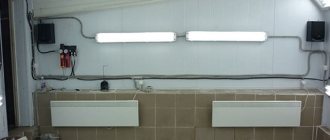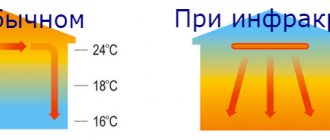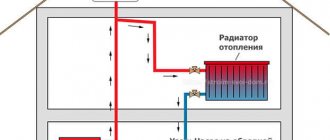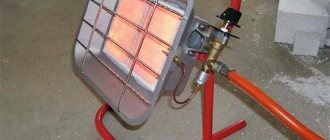Home / Electric boilers
Back
Published: 12/01/2019
Reading time: 4 min
0
2067
Arranging a heating system in a car garage, in situations where centralized heating services are not available, can be a difficult task.
Selecting the optimal electric heating scheme makes it possible to create the required sanitary and hygienic conditions in garage workshops at low outside temperatures, so owners of such premises need to know the basic rules on how to choose an electric boiler for a garage.
Example of EC location in a garage. Photo source: nizhniy-novgorod.dmir.ru
- 1 Types of boilers for garages
- 2 How to calculate boiler power
- 3 Requirements for installing an electric boiler in a garage
- 4 Best brands of garage electric boilers
- 5 How to connect
Features of water heating in the garage
The difficulty of a warm hangar lies in its inconsistent operation. If the heating is turned off for a long time, the circuit may break due to freezing of water in the pipes.
The main feature of water heating in a room is to warm it up to a temperature of + 5-8 0C. This will provide the necessary warm-up to the car and prevent the development of metal corrosion.
Advice! Filling water heating pipes with antifreeze will prevent rupture of system elements when the garage is not constantly heated.
The scheme includes:
- boiler;
- radiators;
- line for supplying hot water and discharging cooled water.
The boiler's job is to heat the water that moves through the pipes to the heating radiators. The cooled liquid is returned to the boiler in reverse and the circuit is cycled.
Pros and cons of heating a garage with water
A warm room for a car saves it from corrosion, peeling paint, and freezing of lubricant. Heating a garage with a water circuit creates optimal storage conditions.
Experts often dispute the advantages and disadvantages of a warm room for a car. There is an opinion that in a heated garage in winter, snow accumulates on the bottom and walls, and when it melts it causes corrosive changes in the metal.
In any case, in a heated room, it is more comfortable for the car owner to carry out maintenance and repairs on a friend on wheels. Some car owners turn on the heating only during repair work, and the car itself is stored in an unheated room.
Knowing the advantages and disadvantages, the car owner independently decides how to store his car.
Conclusions and useful video on the topic
We offer a selection of videos that will help you better understand the issues of heating and insulation of the garage.
Instructions for assembling a super-economical water heating system:
Mini-review of an economical gas stove that consumes 0.5 liters of gas per hour:
Tips for self-assembling an oil heater from a used cast iron radiator:
Video instructions for rational organization of heating in the garage:
Recommendations for reducing heat loss in the garage:
The issue of heating a garage is not difficult to solve. It is enough to understand the main advantages of each heating system and possible limitations in its use. You should choose based on your own needs.
The main thing is not to forget about fire safety rules. No amount of savings is worth putting your car and your own health at risk.
Perhaps you have personal experience in arranging heating for a garage? Please share your own opinion with our readers, tell us which heating system you prefer and why. Leave your comments and ask questions in the block below.
A warm garage in the cold season is an excellent solution. One of the options can be safely called an electric boiler for partial or full heating of the garage. The fact is that the energy carrier used in most cases is already supplied to the vehicle room. So there is no need to think about possible fuel storage. In addition, there is no need to constantly monitor the work - automation can handle this perfectly.
Water heating schemes in the garage
At the design stage of the circuit, the diameter of the pipes is determined. The higher its value, the more efficient the heating will be.
The thermostat increases or decreases the supply of hot water depending on the area of the heated room
Next, calculate the required number of radiators to warm the room. At the design stage, approximate fuel costs are determined. The choice is made on a cheaper and more accessible form of energy.
There are 2 types of heating systems: one-pipe and two-pipe
The water heating circuit consists of a boiler, pipes and radiators.
Red pipes – supply line, blue – return line
The water heated in the boiler flows through pipes into the heating radiators, the metal warms up, transferring heat to the air, which heats the room. The water cooled in the radiators is returned through the pipes to the boiler and heated. It's a continuous cycle.
Water heating is the most economical for heating a garage
In a private house, it is possible to combine the heating system of the garage and the house into one circuit by installing a switch that turns off the heating in the garage. This type is the most budget-friendly
The supply and return lines are located at a slope
Experts recommend installing a unified heating system in cases where the garage is located from the house at a distance not exceeding 40 m.
The heating system of the 2nd floor of the room on which the workshop is located provides for a sequential arrangement of radiators
The gravity scheme includes:
- expansion tank;
- boiler;
- main pipes;
- radiators.
In a gravity system, water is supplied to the radiators through risers. For the garage, it is advisable to install autonomous heating if it is remote from the house, in which case the costs of materials increase. Instead of radiators for heating the garage, you can use pipes with a diameter of 5 to 10 cm. In the hangar, you can install a heated floor, having equipped it with a switch. Complex heating is being installed in a garage cooperative.
Can it be used for heating a living space?
An electric heating boiler can also be installed in a residential area. But for an ordinary residential apartment, one electric boiler will not be enough. It will maintain the temperature in the apartment, but such a system will be very expensive. Electric water heating can only be used in rooms with a small volume (pantry, bathroom) or to provide floor heating (warm floors). But as an auxiliary source of thermal energy, an electric boiler can be used with great success.
The advantages of such a system of 2 boilers are as follows:
- you can quickly achieve the optimal temperature in the room;
- The electric boiler operates silently, so it is used more often in the morning so as not to disturb the sleep of the residents of the house;
- By providing an electric boiler with a control and monitoring system, you can constantly maintain the same temperature in the room, which cannot be achieved when using solid fuel boilers; the cost of paying for electricity will not be very high.
As a rule, the unit is installed in close proximity to the main boiler and connected in series with the main heat source.
Methods for water heating of a garage
The choice of fuel significantly influences the heating scheme in the room. The frequency of operation of the circuit should be taken into account. If the garage is located far from the house and is not heated daily, then during severe frosts the pipes and radiator may rupture. At the design stage, you should carefully consider the type of boiler and type of fuel.
There are several types of fuel:
- gas;
- solid fuel (coal, firewood);
- liquid fuel (used technical oil);
- electricity.
Attention! Solid and liquid fuels require additional storage facilities for storage.
The choice is made based on the cost of fuel and autonomy.
Water heating in a garage without electricity
The most common fuel in the private sector is gas. The advantage of this type is its low cost and availability. Gas heating does not require constant monitoring. With an uninterrupted gas supply, continuous heating is ensured.
However, if the gas pipeline does not pass through the area in which the building is located, they choose a different type of fuel, since it is very expensive to install a gas line.
A gas boiler for autonomous heating is not a cheap pleasure, especially when it comes to heating a garage
Liquid fuel is a low-budget type. The big disadvantage of this heating option is the need for a place to store used oil. You will need a large number of barrels or canisters and a place where you can store all the supplies. This is a fire hazard.
If you have a boiler for liquid fuel, you must constantly monitor its filling level, so you will have to visit the garage often to prevent the heating pipes from bursting
A solid fuel boiler will help you set up water heating in your garage using wood, coal, garbage or pressed briquettes. This option is suitable if the owner can visit the hangar every day and throw a portion into the firebox. After all, in the garage it is enough to ensure a positive temperature; there is no need to warm up the room too much. If a new portion of fuel is not added in a timely manner, the system may freeze and the pipes may burst.
A solid fuel boiler requires a constant portion of fuel, otherwise the system will cool down
For the hangar, you can install water heating using a potbelly stove. This oven is designed for a room up to 30 m2.
Water heating in the garage from electricity
An electric boiler is the most optimal option for a water heating scheme in a room. There is no need for an additional pipeline or storage area to store fuel.
An electric boiler provides reliability and comfort and does not require additional installation of a chimney or supply
Advantages of an electric boiler:
- compactness;
- reliability;
- does not require installation of a supply line;
- does not require the construction of a chimney;
- the device is equipped with a safety system: in case of overheating, the system will turn off;
- can operate on battery power during an emergency shutdown;
- In the event of an emergency power outage, the boiler will start working on its own.
Despite the high cost of electricity, the choice of this heating scheme is optimal, since it is enough to warm the air in the room to positive temperatures, and little fuel is required.
Other types of electrical equipment
You can ensure a comfortable temperature in other ways. Especially if you do not need to constantly maintain heat, but only need local heating, for example in a repair area.
Infrared heaters
Heating a garage with an infrared heater is one such method. Emitters of this type quickly heat the air around them; their main disadvantage is a small heating zone. With the help of infrared heating devices, you can not only increase the temperature, but also defeat dampness or mold, since the radiation acts in a directional manner. However, you should not place garage heating devices very close to the car, since the paintwork may change its properties under the influence of infrared radiation.
Convectors
How different types of heating work
Another option for using electrical equipment is heating a garage with a convector. Modern convector models are equipped with an overheating sensor. You can also choose appliances that automatically turn off when the set temperature is reached. Thus, you can slightly automate the process of heating the garage and not be distracted during work. You can choose a convector with wall or floor installation, with silent operation or ultra-compact. After familiarizing yourself with the different options, you can choose a model that is suitable for its functional features and characteristics specifically for you.
Heat guns
A good option for quickly heating a room is heating the garage with a heat gun. Electric heat guns are powerful heat generators that can heat a room in a matter of minutes. As a rule, heat guns are compact (with the exception of industrial models), so they will not take up much space in the garage. They are also usually equipped with overheating sensors.
To summarize, it must be said that you can use a variety of electric heaters to heat your garage. The main thing to remember when using any electrical equipment is safety precautions. Do not point devices at flammable substances, do not place them near flammable or explosive substances. When installing heating electrical equipment, consult with specialists first. Then you can avoid unforeseen situations and work comfortably in your garage.
Types of water heating garage
Water heating in a garage without a pump can be achieved using a gravity heating system.
There are 2 schemes:
- single-pipe;
- two-pipe.
Single-pipe water heating in the garage
Water heating in the garage from the stove is equipped using a single-pipe scheme. This scheme ensures the sequential passage of coolant through the radiators and return to the boiler.
A single-pipe heating system is easy to install and does not provide uniform heating of radiators
A significant disadvantage of the single-pipe scheme is the uneven distribution of heat. The first radiators will be significantly warmer than the last ones. Experts say that this problem is acute in multi-story buildings and less noticeable in single-story buildings.
Two-pipe water heating in the garage
In a hangar with a large area, experts recommend installing water heating using a two-pipe system. The first pipe pumps heated coolant to the radiators. The second drains waste fluid from the batteries back into the boiler.
The two-pipe system ensures uniform distribution of coolant throughout all radiators
The temperature of the radiators will be uniform, which will ensure uniform heating of the air. The disadvantage of this scheme is complex installation and a large number of pipes and shut-off elements, which increases its cost.
What type of heating is most profitable?
It all depends on the specific operating conditions and preferences of the garage owner. The cheapest system is a single-pipe water system powered by a gas boiler.
You will have to invest a lot of money in its arrangement, but it is so economical that the costs will be recouped in 1-2 heating seasons. However, this solution is not suitable for everyone.
You can economically heat your garage using gas cylinders or solid fuel. These options are not suitable if it is not possible to control the operation of the devices, but they are good for heating while the owner is in the garage.
How to make water heating in a garage
Arranging water heating from a potbelly stove in the garage is advisable if the area does not exceed 30 m2.
To install the system you will need:
- oven or boiler;
- cast iron radiators;
- metal pipes with a diameter of 5-10 cm for arranging the main line;
- locks, screws, fasteners.
The number of radiators and sections in them is determined based on the heated area of the building and the expected fuel consumption. Standard formula: 1 equals 100 watts. Calculations for 20 m2: 100*20=2000 W. The package indicates the heat transfer index of 1 section, for example, for cast iron - 120 W. 2000/120= 16.67 sections. This formula is used to heat a living room. It is not necessary to warm up the garage to a temperature of 20 0C, so experts advise dividing all calculations by 2. For a room of 20 m2, 16.67/2 = 8.33 sections will be required. The value is rounded up or down.
Attention! The diameter of the pipe affects the heat transfer. The higher the value, the more efficient the heating of the room and the lower the fuel costs.
During the installation process, metal pipes are assembled into the system using a welding machine, and plastic pipes using a soldering iron. For natural circulation of the coolant, the pipes are placed at a slope.
The water heating circuit assumes the presence of an expansion tank. It is made from a canister or other plastic or metal container. In the upper part of the tank there is a hole for adding coolant, as the liquid heats up and evaporates.
The boiler is installed in a permanent place and pipes are supplied
Install the boiler. Pipes and, if necessary, a chimney are connected to it.
The boiler is installed in a permanent place and pipes are supplied
Radiators are hung on fasteners, evenly distributed around the perimeter of the room. The distance from the floor is at least 15 cm. A gap of 5 cm is left between the wall and the battery.
Radiators are hung from the wall and main pipes are supplied
Using main pipes, the entire structure is connected into a single circuit. When welding or soldering pipes, experts recommend paying attention to the quality of the seams. The circuit is filled with coolant and turned on for testing.
Electric heating
The simplest and relatively affordable method is electric heating, for the arrangement of which it is enough to purchase the appropriate equipment. A wide variety of options, mobility and compactness are the main advantages. However, costs will directly depend on the established electricity tariffs.
Before installing electric heating, you need to choose the most suitable device:
- Electric inverter
- Infrared heater
- Heat gun
Among the types of electric heating, the most effective is the inverter or “heater”. There are a huge number of models on the market that are installed on the floor or hung on the wall. They are quite compact, but at the same time very productive.
The approximate cost of an electric inverter is from 10 thousand rubles.
A compact and effective solution is the installation of IR heaters - a fairly powerful and productive device
However, paying attention to the rapid heating of the room, they are not able to cope with large areas. Negative aspects are also high energy consumption and prices for corresponding installations
Find out more about infrared heating
The average cost of an infrared heater is from 4 thousand rubles.
Heat guns are considered compact, efficient and convenient, capable of heating a garage space in the shortest possible time. They consist of a heater and a fan that dissipates heat into the environment. However, to connect such equipment, it is necessary to have a single-phase network with a large cross-section of the wire being laid or a 3-phase network (the latter is preferable).
The cost of heat guns is from 5 thousand rubles.











